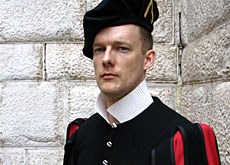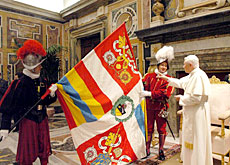Swiss Guard book leafs through 500 years

A member of the Swiss Vatican Guard tells swissinfo the 500-year history of the army has been marked by moments of heroism as well as human weakness.
Christian-Roland Marcel Richard has just published a book on the papal guard – the first history of the pope’s personal army to be written by a serving guardsman.
Swiss Guards Across the Centuries tells the story of the Sack of Rome in 1527 when 147 guardsmen died trying to protect the pope. It also relates the fateful events of May 4, 1998 when a guardsman shot dead the new commander, Alois Estermann, and his wife before turning the gun on himself.
Sergeant Richard said that while the fundamental duties of the Guard had changed little, the world’s smallest army had had to adapt to different times and consecutive popes.
Born in 1970, Richard has served at the Vatican since 1993.
swissinfo: How did you manage to combine the job of guardsman with writing the book?
Christian-Roland Marcel Richard: As soon as I arrived at the Vatican in March 1993 I began collecting material on the history of the Guard. I wanted to understand the reasons why Swiss citizens first entered the service of the pope and why they are still doing so today.
I fitted the research in around my evening and day duty, guarding papal Masses, audiences and receptions. In total I spent 2,962 hours on this work.
swissinfo: How has the life and work of the Swiss Guard changed over the past 500 years?
C-R.M.R.: The first article of the Swiss Guard regulations, which entered into force on June 28 1976, defines our function clearly:
“The Swiss Pontifical Guard, founded by Pope Julius II in 1506, is a military corps composed of Swiss citizens, whose principal task is to constantly ensure the security of the holy successor of Saint Peter and his residence.
Other duties are to accompany the Holy Father on his travels, guard access to Vatican City and carry out other official and ceremonial duties as listed in the regulations.”
The reasons for having the Swiss Guard have not changed over the course of the centuries. The Guard has simply adapted to the changing times and the wishes of the different popes it has served.
swissinfo: What is life like for a modern-day guardsman?
C-R.M.R.: The corps is divided into three sections. Guard duty rotates among these sections every 24 hours. Two sections are needed to cover the normal daily service. During general audiences, ceremonial occasions, state visits etc., the section that is not in duty can be called up in part or in its entirety.
Every month there are free mornings given over to exercise, theory and training. If a guardsman doesn’t know Italian, he has to do a language course and pass an exam.
swissinfo: In the book you write about the 1998 murder of commander Alois Estermann and his wife by a guardsman. Has the Swiss Guard recovered from that dark episode?
C-R.M.R.: That recent event is now part of the Guards’ history. I mention it after the [1981] attack on the life of John Paul II. Greatness and heroism, but also fragility and human frailness have left their indelible mark on the 500 years of our history. I described the facts according to the official documents available.
I was at the Vatican when this event took place.
Around 90 per cent of guardsmen leave the corps after completing the obligatory two-year term. Now almost eight years on, very few guardsmen who were serving in 1998 are still around. And the new guardsmen who weren’t directly affected don’t feel the need to talk about it.
swissinfo: Can you imagine women ever serving in the all-male Guards?
C-R.M.R.: The Swiss Guard has a very old military tradition and its members have a moral duty to preserve and uphold the memory of their predecessors. To change the institutional values on which the Guard was founded simply to comply with current trends would be to take away its reason for being.
swissinfo-interview: Morven McLean
Swiss Guards Across the Centuries is published in Italian by Leonardo International.
Brought out to mark the 500th anniversary of the Guard in 2006, the book was launched in November.
The 256-page history is illustrated with black-and-white and colour photographs and costs €50 (SFr77).
The publisher plans to bring out French, German and English versions.
Christian-Roland Marcel Richard is a native of Fully, canton Valais. He was born in 1970.
After military service in Switzerland, Richard took up service at the Vatican on March 1, 1993.
He has risen to the rank of sergeant, and is now the oldest native French speaker in the Guards.
Richard has been awarded two medals for service: the Benemerenti and the Pro Ecclesia et Pontifice cross of honour.

In compliance with the JTI standards
More: SWI swissinfo.ch certified by the Journalism Trust Initiative


You can find an overview of ongoing debates with our journalists here. Please join us!
If you want to start a conversation about a topic raised in this article or want to report factual errors, email us at english@swissinfo.ch.